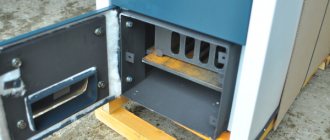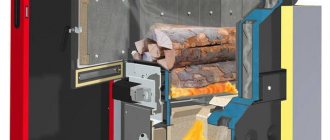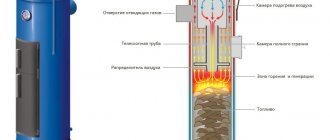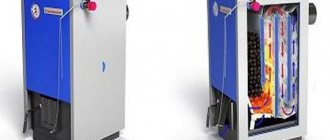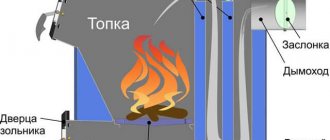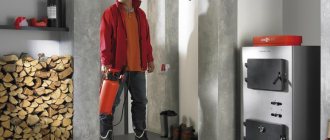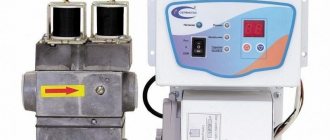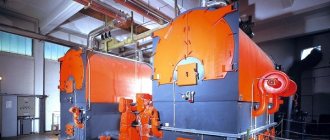Advantages and disadvantages of long-burning boilers
Among heating equipment designed to produce thermal energy used for heating and hot water supply to domestic and industrial facilities, long-burning boilers operating on solid fuel occupy a special place. Such attention to such equipment is associated with the presence of a sufficient number of advantages, in comparison with analogues, when using them, which can be formulated as follows:
- high efficiency of use;
- environmental Safety;
- relatively low cost of fuel used;
- versatility (heating and hot water supply);
- long service life;
- ease of maintenance.
The industry produces units of various types and designs, differing in technical characteristics, types of solid fuel and cost.
Along with this, of course, there are also disadvantages, but they are disproportionately smaller:
- the need to have certain reserves of fuel used;
- labor-intensive maintenance, expressed in periodic cleaning of chimneys and boiler chambers;
- The installation site is subject to strict requirements regulated by fire safety rules and building codes.
Features and principle of operation of long-burning boilers
Unlike an ordinary stove, a solid fuel boiler makes maximum use of the thermal properties of organic fuel. During the combustion of wood, coal or peat, in addition to carbon dioxide and water vapor, hydrocarbons are released, which are pyrolysis gases that are not used when burning fuel in a conventional furnace. The amount of heat released during the combustion of these compounds is significantly higher than the heat transfer during simple combustion of wood.
The operating principle of solid fuel boilers is based on the use of pyrolysis gases as an energy carrier and minimizing the use of open fire. Thus, organic fuel, in fact, is not a direct source of heat, but serves as a raw material for the production of gaseous hydrocarbons, and open combustion is replaced by smoldering with minimal access of oxygen.
Types of long-burning solid fuel boilers for heating
Long-burning solid fuel heating boilers used for home heating come in two types:
- Shaft or top combustion boiler . In such devices, fuel combustion occurs in its upper layers, and the heat exchanger is the entire boiler body. Air is supplied to the stacked firewood (coal) through a special telescopic tube from top to bottom, after which, moving in the opposite direction, it promotes the combustion process.
- Top combustion (mine) boilers are universal in terms of the types of solid fuel used (coal, firewood and processed waste from wood processing industries)
- Pyrolysis boilers (gas generators) . Combustion in such units occurs from top to bottom, and the process itself is carried out with limited access to oxygen, resulting in the formation of ash and pyrolysis gas, which, in turn, is burned in the combustion chamber.
Types of solid fuel boilers
Solid fuel boilers are manufactured only with a floor-mounted installation option; they can be designed to burn only one type of fuel, like classic units, or for different types of fuel, like pyrolysis and pellets.
The devices are often produced as single-circuit ones, but in most versions they have the ability to turn on an external boiler for indirect DHW heating. In addition, modern solid fuel boilers are equipped with electric heating elements to maintain the temperature of the internal heating circuit at night or in the absence of residents of the house.
Classic
These modifications of the units are already more than two hundred years old and they have a traditional design. They are equipped with a combustion and ash chamber, a capacitive heat exchanger in the form of a water jacket and a smoke ventilation system.
Such units operate on any solid fuel. They are ineffective because they do not have developed heating surfaces. This leads to large heat losses in them with flue gases, of the order of up to 20%.
In addition, they do not have automatic fuel supply; fuel is filled manually every 2-3 hours. The units operate with natural exhaust of flue gases into the atmosphere; the combustion process is controlled manually, through an air supply control valve.
The heating circuit is connected to the in-house heating system, which operates on the principle of natural circulation. Typically, the power of such units is not high; they are capable of heating houses with an area of no more than 150 m2.
Pyrolysis
The normal functioning of units of this class occurs in the generation mode based on smoldering fuel with the release of volatile substances. In heating engineering, such a technological process is called pyrolysis.
As a rule, wood is used as energy carriers. Under the influence of high temperatures and air deficiency, they split into gaseous volatile substances, which burn in the pyrolysis chamber, generating thermal energy, which is transferred through the heat exchanger to the heating coolant of the heating circuit.
To implement the pyrolysis process, the firebox is divided into 2 working chambers. In the main stage, the fuel smolders, releasing flammable gases that burn out in the afterburning zone at a temperature of 1200 C, enriched with secondary air.
Peletnye
Such boilers burn specially prepared fuel - pellets in the form of granules obtained during the processing of industrial and agricultural waste: sawdust, plant fragments and peat.
They are characterized by low humidity and a very high calorific value and a certain fluidity, which makes it possible to organize the automatic supply of fuel to the boiler without human intervention.
The boilers are equipped with an automatic ignition and combustion process control system, which results in high efficiency indicators - efficiency up to 92%. The units are capable of heating rooms with a large area - 1000 m2. They are environmentally friendly because they ensure complete combustion of harmful substances in the fuel.
Device, principle of operation and technical characteristics
Different types of long-burning boilers differ in their design, operating principle, and also have their own advantages and disadvantages, as a result of which they should be considered separately from each other.
Long burning mine boiler
The design of a top combustion boiler is shown in the following figure, which shows that the main elements of such units are:
- the housing on which the operating control elements are mounted (air supply regulator, fuel loading doors and ash pan, chimney);
- air heating and fuel combustion chambers;
- supply tube and air distributor;
- pipes for connecting to the heating system.
Design and appearance of a shaft-type unit
A mine boiler can be designed as an independent heat source or be an element of a heating system, as shown in the above figure. In this case, a boiler of this design is called a single-circuit boiler with a water circuit. The operation of a heating boiler of this type is carried out as follows:
- after loading the fuel and igniting it, the air supply regulator is open, it ensures its flow into the upper layer of the stored fuel through a movable distributor;
- as the fuel burns out, the distributor moves down, thereby providing air to its lower layers;
- the fuel burns evenly layer by layer, releasing flammable wood gas;
- the gas enters the second chamber (afterburning chamber), where it ignites and, when burned, releases a large amount of thermal energy;
- A water circuit is mounted in the boiler body, through which the heating system coolant circulates, so the entire area of the boiler is its heat exchange element.
The main technical characteristics of such equipment are:
- power, measured in kilowatts (kW);
- heated area (m2);
- the amount of fuel available for placement in the combustion chamber (m3 and kg);
- size of firewood that can be used, (cm) – for boilers burning wood;
- the amount of water in the boiler jacket;
- duration of burning of one bookmark;
- efficiency;
- maximum possible pressure in the heating system;
- geometric dimensions of the boiler as a whole and its individual elements;
- weight.
Long-burning pyrolysis boiler with water circuit
The design of a pyrolysis boiler involves supplying air from above to the stored fuel (wood), which is ensured by its primary supply system. The stored firewood begins to smolder after ignition, which is achieved by the design of the boiler, which provides a limited air supply at this stage of operation.
Design of a solid fuel pyrolysis unit
The wood gas released in this case (pyrolysis effect) enters the second chamber, where it is mixed with secondary air and burned. Due to the fact that the process of fuel pyrolysis takes a long time, the operation of the boiler on one bed is also quite long. Pyrolysis gas, when burned, gives up its heat to the coolant circulating in the heat exchanger of a solid fuel boiler, equipped with a water circuit and connected to the heating system. The main technical characteristics of pyrolysis boilers are:
- type of fuel used;
- material used in manufacturing;
- burning duration on one tab (hours);
- power, kWt);
- heated area (m2);
- number of circuits;
- efficiency;
- fuel consumption (kg/h);
- dimensions of the boiler, firebox and other structural elements;
- weight (kg).
Types of long-burning boilers
In addition to the fact that long-burning boilers differ in their design (type), they may also have differences in such parameters as the presence of an automation system and a different number of water circuits. The presence of two circuits in the boiler design allows it to be used not only for heating, but also as a source of hot water supply. In such models, one internal circuit of the unit is included in the heating system, and the second - in the hot water supply system. An automatic solid fuel boiler is a set of technical means that ensure the operation of a heating device without human intervention in this process. The highest degree of automation is found in boilers that use pellets (fuel granules) as fuel, made from wood processing waste (sawdust, wood chips, etc.).
Model "Viessmann Vitoligno 100-S"
Design and operating principle of long-burning heating boilers
To understand how the boiler functions, as well as to facilitate the process of its future maintenance, you need to familiarize yourself with the design and principle of operation.
The principle of long burning is that, firstly, such boilers have a very voluminous firewood loading chamber. And secondly, that fuel combustion does not occur immediately, but is broken down into two stages.
- Firewood (or other solid fuel acceptable for this model) is placed in the combustion chamber. This compartment should be filled to almost its entire volume. Only at the very loading window do they try to lay out thin logs, wood chips, branches, etc. – to facilitate initial ignition.
Long-burning boilers are always distinguished by a very capacious fuel chamber, which is tightly filled with firewood “to capacity”
- Next, using a torch or paper, the fuel supply is ignited. At this stage, a sufficient amount of air is supplied to the chamber, necessary for intense combustion to occur.
- Once the fuel is ignited, the supply of air to this primary combustion chamber is reduced to a minimum. Thanks to this, the usual active burning of wood stops and goes into the stage of thermal decomposition, in other words, smoldering.
- Under such conditions, smoldering wood, during its decomposition, releases very significant volumes of combustible gases with high energy potential. This process is called pyrolysis, and the gases themselves (which are dominated by methane) are accordingly often called pyrolysis.
- If in conventional furnaces the resulting pyrolysis gases simply go into the chimney, then in long-burning boilers they enter a specially designed afterburner chamber. Here, under the influence of high temperature and excess supplied oxygen (air), the gas mixture ignites and completely burns out with a very significant release of heat. As a result of the full cycle, there is practically no waste left from the firewood, since its solid component is destroyed by smoldering to the smallest ash, and the gaseous component burns out intensively in the afterburner. This in total determines the high heat transfer of the boiler and its high efficiency.
It is the formed pyrolysis gases that are the main source of thermal energy, and it is their afterburning chamber that accounts for the main part of the water circuit heat exchanger. Although, of course, heat extraction begins in the primary combustion chamber.
You may be interested in information about what characteristics solid fuel has for briquette boilers
To make it more clear how such boilers are approximately arranged, you can consider the following diagram:
One of the options for a long-burning boiler
1 – boiler body with a reliable layer of thermal insulation.
2 – firewood loading window with a tightly closing door.
3 – chamber of primary thermal decomposition of wood (pyrolysis).
4 – ash pit in which unburnt waste is collected.
5 – channel for dosed supply of primary air necessary to ensure smoldering of firewood
6 – channel for supplying secondary air, necessary for complete afterburning of bleached pyrolysis gases.
7 – afterburning chamber of pyrolysis gases.
8 – pipe for connecting the boiler to the chimney to remove combustion gases.
9 – pipe for connecting the return pipe of the heating circuit.
10 – pipe for connection to the heating circuit supply pipe.
11 – additional heat exchanger, which is often used to connect the indirect heating boiler of a home’s hot water supply system
Of course, such a scheme is not at all some kind of dogma. The number of models offered for sale is large, and the layout can have very significant differences. In particular, the structure of the loading chamber, the direction of combustion of the fuel fill, and the location and design principle of the secondary afterburning chamber of pyrolysis gases may differ. Each model has its own “water jacket” design or additional heat exchangers. But the principle of operation of the boiler still remains similar.
Before you start using the selected model, you must carefully study the diagram of its design, which is necessarily included in the documentation accompanying this heating device.
You may be interested in information about the advantages of autonomous gas heating in an apartment
How to calculate the power of a heating boiler
The power of the boiler determines its performance and at the same time affects the cost of the heating unit; the higher the power, the more expensive the heating boiler. In this regard, in order to avoid unnecessary financial expenses, when choosing a long-burning boiler, you need to calculate the required power of such a device, which can be done in two ways:
- Considering the average specific power per unit of heated area . In this case, the value taken as a basis is 1 kW per 10 m2, with a ceiling height of up to three meters. Dividing the available area of the premises that need to be heated by 10, we obtain the approximate power of the heating boiler. No. 18. A long-burning wood boiler will ensure the autonomy of the heating system of a country house
- Using the volume of the heated room and the degree of its thermal insulation . In this case, the calculation is performed using the formula:
P = S × h × k , where
P – heating boiler power (kW);
S – area of the heated room (m2);
h – height of the heated room (m);
k - a coefficient that takes into account the degree of thermal insulation, is equal to 40 - for well-insulated rooms and 60 - with poor thermal insulation and a large glazing area of building structures.
For more accurate calculations, we suggest using a convenient online calculator.
Types of fuel for long-burning boilers
Simultaneously with the advent of solid fuel heat generators, in addition to firewood and coal, alternative combustible materials appeared on the market. Currently in highest demand are:
Pellets
– waste from the woodworking and furniture industries, pressed into briquettes. You can not only buy pellets at a construction supermarket, but also make them yourself.
Sawdust and wood chips
. This type of fuel is the cheapest; moreover, there have been cases when sawmill owners even paid extra for waste removal. The amount of heat released during the combustion of the material is quite acceptable, and the air contained between the individual elements makes the combustion process more intense and uniform.
Briquettes
They are produced using the same technology as granulated pellets and differ only in shape. Most often, briquettes are in the form of natural logs with a through hole in the center. The heat transfer of the material is practically no different from granules.
How to choose a long-burning wood-burning boiler - recommendations from our editors
It is sometimes difficult for an untrained user to choose this or that technical equipment, because... the variety of offers does not allow you to concentrate on the main selection criteria - which ultimately leads to unnecessary financial expenses or the inability of the purchased device to cope with the assigned tasks.
Heating equipment must be installed in specially designed rooms.
Our editorial specialists recommend paying attention to the following points when choosing a wood-burning boiler model:
- Initially, you should determine the required power of the heating device and its scope of use (heating, heating + hot water supply);
- It should be remembered that in the manufacture of such equipment, steel or cast iron is used, and each of the materials used has its own advantages and disadvantages;
- Reliability is guaranteed by the manufacturer, so you need to find user reviews about the model you like, as well as about the company as a whole.
Which long-burning boiler is best to choose for heating a home?
When choosing the necessary modification, you need to consider several important points:
Selecting a fuel type
is purely individual and depends on its availability and cost. For example, near a logging site it is advisable to use firewood; in industrial areas it is easier to purchase the necessary supply of coal.
Determination of the required power characteristics.
The efficiency of the entire heating system depends on the correct determination of the required equipment performance. You can roughly estimate the required power based on the ratio of 10 kW per 100 m2 (+ 10% for unforeseen circumstances).
Estimation of loading chamber volume
. For modern solid fuel boilers, the optimal ratio is 3.3 – 5 l/kW.
Installation and operation rules
In order for the operation of heating equipment to be long-lasting and trouble-free, it is necessary to initially install it correctly and then use it correctly.
Pyrolysis boiler during operation
When installing long-burning boilers, you must:
- Protect building structures from exposure to high temperatures and possible contact of burning fuel parts with their surface.
- The chimney should have the least amount of bends, its height above the roof surface should correspond to its shape.
- The connection between the boiler and chimney must be removable.
Installation and operation rules are described in the accompanying documents for the specific model; however, when using such equipment, you should remember that:
- Firewood must be laid loosely in the firebox to ensure air circulation;
- the amount of incoming air (draft) can be adjusted using a damper and an ash pan;
- Maintenance of long-burning boilers operating on solid fuel consists of removing ash and cleaning the grates, as well as cleaning the chimney.
Models from different manufacturers are very similar in appearance, so when choosing a specific device, you should carefully study the technical characteristics, as well as the requirements for installation and operation
Homemade long-burning boilers with wood - manufacturing nuances
If you have free time, the ability to work with hand tools, and also the desire, you can make a long-burning wood-burning boiler yourself. When making it yourself, you must remember that:
- The larger the chamber intended for loading fuel, the longer the burning process will be.
- The ash chamber must be closed hermetically, because air enters the working area of the boiler from top to bottom.
- A damper must be provided in the upper chamber to regulate the air supply.
- To ensure long-term operation of the unit being constructed, the metal thickness must be at least 5 mm.
When making a mine boiler yourself, you can use a gas cylinder with a volume of 50 liters
Types of solid fuel boilers
Despite the fact that the principle of afterburning pyrolysis gases underlies all long-term combustion units, their design features can vary significantly. Most manufacturers offer universal systems that can operate on any solid fuel. Currently, there are several most common modifications of solid fuel boilers.
Long-burning boilers with forced air supply
are equipped with a special fan, the speed of which is regulated by an electronic control unit. Most often, such installations have a top loading, and the final combustion is carried out in a lower chamber made of fireclay or heat-resistant ceramic concrete.
The location and shape of the chamber for burning pyrolysis gases may differ for different models of solid fuel boilers. Thus, Gefest-profi installations have a labyrinth afterburning chamber located behind the pre-combustion department.
Non-volatile pyrolysis boilers with natural draft
. Such a unit can operate autonomously, regardless of the availability of electricity. This design is simple and reliable; in addition, it can operate on any fuel.
The lower chamber provides conditions for continuous smoldering of the fuel. The heated gases rise into the upper cavity, where they react with preheated air. As a result of this interaction, combustion of hydrocarbon compounds occurs, releasing a large amount of thermal energy.
Solid fuel boiler with vertical combustion of fuel
. This principle is applied in products of the Stropuva trademark. The main feature is that combustion occurs only in the upper layer of the loaded combustible material, which ensures minimal fuel consumption with maximum combustion duration.
After loading and switching to low combustion mode, the intensity of which is regulated by a special damper, the pyrolysis products rise into the upper chamber and finally burn out.
Installations with automatic fuel supply
. In such boilers, the combustion duration is increased due to the uniform supply of fuel to the pre-combustion zone using a screw conveyor. Most often, coal is used as fuel, but there are models for other types of fuel.
As for the use of firewood or coal in various modifications of solid fuel boilers, we can say that they may have different design features related to the configuration and properties of the materials being burned. Despite this, the operating principle based on the use of pyrolysis hydrocarbons remains unchanged.
How much does a long-burning boiler cost - price review
The following table shows the average cost of long-burning boilers discussed in this article as of the second quarter of 2021.
| Model | Price, rubles |
| "STROPUVA S 40" | 120 000 |
| "Candle S-18kW" | 88 000 |
| "BuderusLogano G221-40" | 105 000 |
| "Geyser PK-10" | 45 000 |
| "ViessmannVitoligno 100 VL1A025 30 kW" | 245 000 |
| "Bourgeois K TA 20" | 65 000 |
| "BuderusLogano S111 20" | 75 000 |
| "Stropuva S10" | 90 000 |
| "ViadrusHercules U22D-4" | 55 000 |
You can buy an inexpensive long-burning wood-burning boiler from the company that produces it, as well as its dealers, on the Internet, where there are also a large number of offers from organizations involved in the sale of such equipment.
FAQ
Why does the pressure drop in an electric heating boiler? There may be several reasons for this. First of all, the pressure in the system drops during the first start-up, when air comes out of the pipes filled with coolant - this is a completely normal phenomenon; there are even special air vents for this. This process can take quite a long time, up to two weeks in a system with heated floors. In addition, it is possible that the expansion tank, whose task is precisely to contain pressure drops, is almost filled with coolant. If there is no room for air in the tank, excess pressure in the system will be released through the relief valve. Finally, the most unpleasant and most common reason is a leak in the heating system. In this case, the leak must be identified and repaired so that the pressure stops falling.
